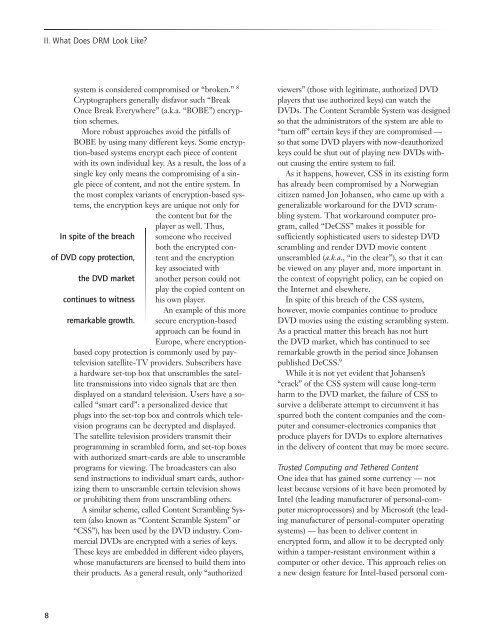What Every Citizen Should Know About DRM, aka - Public Knowledge
What Every Citizen Should Know About DRM, aka - Public Knowledge
What Every Citizen Should Know About DRM, aka - Public Knowledge
Create successful ePaper yourself
Turn your PDF publications into a flip-book with our unique Google optimized e-Paper software.
II. <strong>What</strong> Does <strong>DRM</strong> Look Like?system is considered compromised or “broken.” 8Cryptographers generally disfavor such “BreakOnce Break <strong>Every</strong>where” (a.k.a. “BOBE”) encryptionschemes.More robust approaches avoid the pitfalls ofBOBE by using many different keys. Some encryption-basedsystems encrypt each piece of contentwith its own individual key. As a result, the loss of asingle key only means the compromising of a singlepiece of content, and not the entire system. Inthe most complex variants of encryption-based systems,the encryption keys are unique not only forthe content but for theplayer as well. Thus,In spite of the breach someone who receivedboth the encrypted contentand the encryptionof DVD copy protection,key associated withthe DVD market another person could notplay the copied content oncontinues to witness his own player.An example of this moreremarkable growth. secure encryption-basedapproach can be found inEurope, where encryptionbasedcopy protection is commonly used by paytelevisionsatellite-TV providers. Subscribers havea hardware set-top box that unscrambles the satellitetransmissions into video signals that are thendisplayed on a standard television. Users have a socalled“smart card”: a personalized device thatplugs into the set-top box and controls which televisionprograms can be decrypted and displayed.The satellite television providers transmit theirprogramming in scrambled form, and set-top boxeswith authorized smart-cards are able to unscrambleprograms for viewing. The broadcasters can alsosend instructions to individual smart cards, authorizingthem to unscramble certain television showsor prohibiting them from unscrambling others.A similar scheme, called Content Scrambling System(also known as “Content Scramble System” or“CSS”), has been used by the DVD industry. CommercialDVDs are encrypted with a series of keys.These keys are embedded in different video players,whose manufacturers are licensed to build them intotheir products. As a general result, only “authorizedviewers” (those with legitimate, authorized DVDplayers that use authorized keys) can watch theDVDs. The Content Scramble System was designedso that the administrators of the system are able to“turn off” certain keys if they are compromised —so that some DVD players with now-deauthorizedkeys could be shut out of playing new DVDs withoutcausing the entire system to fail.As it happens, however, CSS in its existing formhas already been compromised by a Norwegiancitizen named Jon Johansen, who came up with ageneralizable workaround for the DVD scramblingsystem. That workaround computer program,called “DeCSS” makes it possible forsufficiently sophisticated users to sidestep DVDscrambling and render DVD movie contentunscrambled (a.k.a., “in the clear”), so that it canbe viewed on any player and, more important inthe context of copyright policy, can be copied onthe Internet and elsewhere.In spite of this breach of the CSS system,however, movie companies continue to produceDVD movies using the existing scrambling system.As a practical matter this breach has not hurtthe DVD market, which has continued to seeremarkable growth in the period since Johansenpublished DeCSS. 9While it is not yet evident that Johansen’s“crack” of the CSS system will cause long-termharm to the DVD market, the failure of CSS tosurvive a deliberate attempt to circumvent it hasspurred both the content companies and the computerand consumer-electronics companies thatproduce players for DVDs to explore alternativesin the delivery of content that may be more secure.Trusted Computing and Tethered ContentOne idea that has gained some currency — notleast because versions of it have been promoted byIntel (the leading manufacturer of personal-computermicroprocessors) and by Microsoft (the leadingmanufacturer of personal-computer operatingsystems) — has been to deliver content inencrypted form, and allow it to be decrypted onlywithin a tamper-resistant environment within acomputer or other device. This approach relies ona new design feature for Intel-based personal com-8





